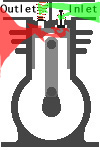A modern"Vacuum pump" in the classroom.
A "vacuum pump" is so named for its function. It is really
an air pump that is
specifically designed to reduce the air pressure of a connected
chamber.
You may have seen the use of such a pump in class as part of
a classical physics demonstration.
The problem with the use of such a pump is that its process
is hidden deeply within an iron
casing, no knowledge imparted to the class during physics demonstrations
as to its specific operation.
Because it is an expensive and delicate piece of scientific
equipment, instructors often do not
allow students to touch or operate the machine.
It is very important to introduce newcomers to both the concept
and the feel as what it
takes to create this kind of reduced pressure in a connected vessel.
What the vacuum service air
pump isn't.
It is a common misconception that a lab vacuum pump is nothing
more than an air compressor that is used to "suck" air out
of things.
Such reciprocating piston machines are quite unsuitable for
the low pressures necessary for
modern physics demonstrations like electrical discharges in
rarefied air and other gases.
There are spaces in a
typical piston-type air
compressor that are not
part of the volume that is
displaced or swept by
the piston.
These include the valve
passages, pockets and the annular
spaces
around the piston above
the sliding ring seals.
This leftover parcel of air
cannot be expelled, stays
in the fixed volume of the pump and is uselessly
reworked over repeatedly.
|
 |
Some amount of air
pressure is necessary
to open the check
valves in a typical air
compressor.
There is plenty
of pressure to open the
valves in pressure
service.
There is not enough
force by the lowered
pressure air of vacuum
service to open
the spring loaded
valves.
|
The same goes for diaphragm pumps.
Next page---->
